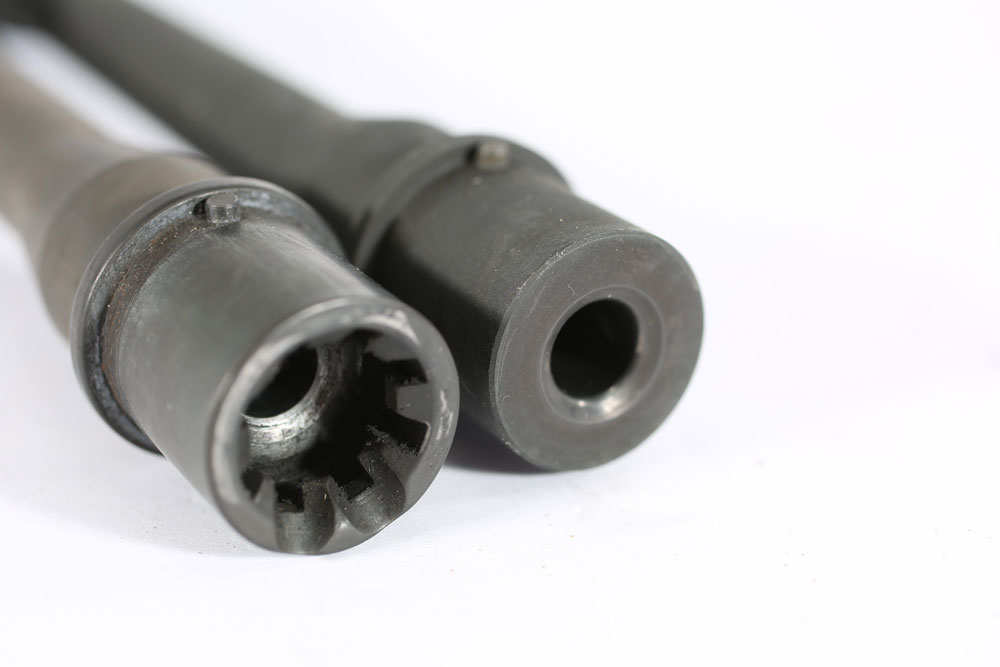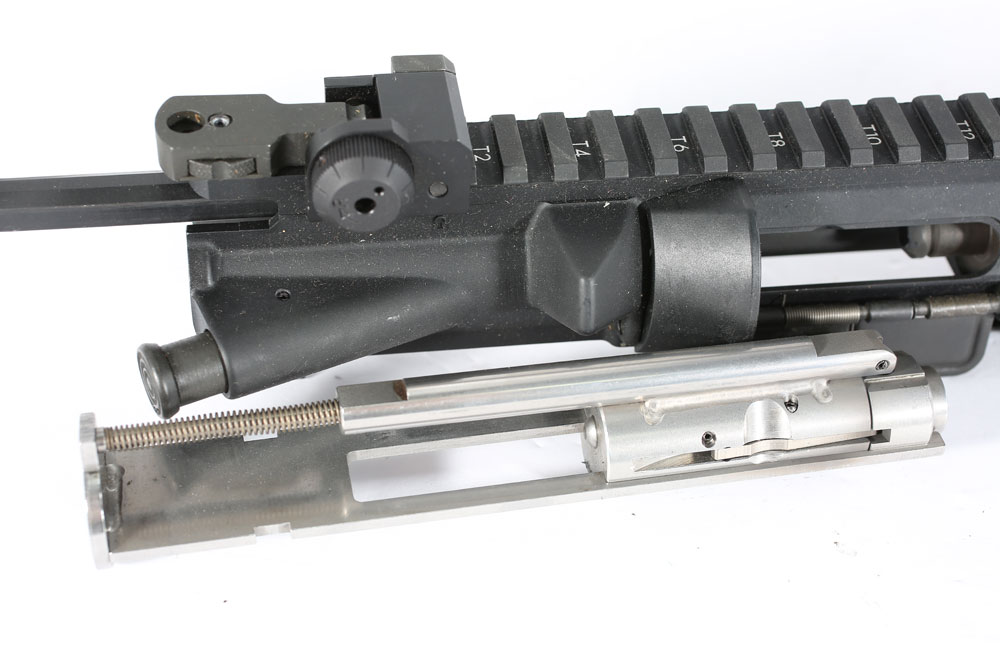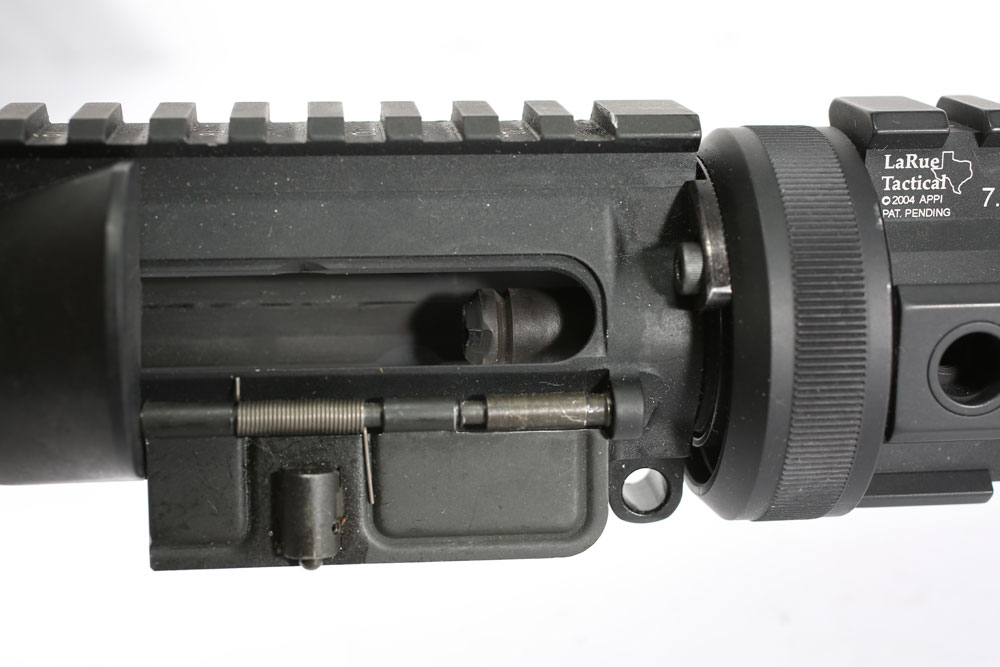

The noise generated by shooting a centerfire rifle indoors can make the experience kind of unpleasant. Not all indoor ranges are up to the task of dealing with .223/5.56. New shooters are also sometimes not happy with the noise and recoil of the .223. The 9mm might have the same recoil, but it has less noise. And the lowly .22 LR? Noise and recoil free. A 9mm or .22 LR make good sense in certain situations. Building one is pretty easy.
9mm
You’ll need a 9mm barrel and bolt, a conversion block for the magazine well (or a Rock River 9mm-specific lower) and a replacement buffer weight.
The 9mm barrel replaces the .223. The backend of the barrel is the same external size and shape, and the barrel nut is the same. However, since the 9mm is a blowback design, you won’t need the gas tube. You will see the stub of a gas tube on some of them, still attached to the front sight housing. It is there to keep the handguards from rotating and prevent the barrel nut from unscrewing. Yep, seen it happen. And since there is no need for a gas tube, the key on top of the carrier is there solely to keep the bolt correctly oriented. That’s why it is cut back on a slant.
Install the stock (most shooters opt for a telestock, which makes things easy) and lower internals just as you would any other build. The conversion block comes in two types: one inserted from beneath and held in place by the mag catch, the other from the top, held in by lips that keep it from falling out. Opt for the top-loading one.
Colt uses a pair of blocks pinned into the mag well. If you get a conversion set of parts like this, free or cheap, go for it. Make the top decks of the adapter blocks even with the top of the lower receiver, press hard forward and aft, and drill and pin. Otherwise, go for a 9mm-specific lower (Rock River makes one) or the blocks inserted from the top.

The barrel is installed like any other. Just keep in mind the need to secure the handguards or the barrel nut. A free-float handguard would be very good here.
The 9mm needs the heaviest buffer weight you can get. The H3 will work, if you can’t get a 9mm-specific Colt one. The 9mm uses the same buffer spring as any other carbine.

As mentioned, the bolt is a blowback type and machined without locking lugs. In fact, the carrier is the bolt — it is all one piece.

Last, you may find that some hammers are less forgiving of the 9mm bolt/carrier. If you use a standard .223/5.56 lower internals set, you may find the hammer is the problem. Swap it for a lightened, match-type one and things will work better.
The 9mm barrel has different threads at the muzzle than the ./223/5.56. The thread pitch there is ½-36, instead of ½-28. This is to prevent you from installing an undersized flash hider on your 9mm barrel. However, the ½-36 threads can cause headaches when you go to mount a suppressor. A handgun 9mm suppressor will have threads of ½-28, but that won’t work on your 9mm carbine.
That’s not a problem since the handgun suppressor mount features a booster, which the carbine doesn’t need. So, your suppressor needs a rear cap that is threaded ½-36. The 9mm bore explains why the handgun caliber barrel profiles tend to be heavier. Even at their thinnest, 9mm barrels are larger in diameter than 5.56.
9mm AR magazines are modified Uzi mags. Back in the old days we had the choice of a mondo-expensive Colt mag, or a dirt-cheap Uzi mag, requiring machining with an end mill. Now, there are plenty of 9mm magazines to be had, no need to go cutting on any.

.22 LR
A rimfire conversion involves only the upper, unless you find that the hammer is too heavy, a problem solved with a lightened match hammer. Also, the rimfire conversion does not need any specific buffer weight, as the .22 LR doesn’t generate enough recoil to push the buffer.
But you will need a buffer and spring installed, to keep the rimfire adapter in place.
The conversion is a bolt with built-in recoil springs and a forward part that looks like a .223 cartridge, lacking a bullet. That part fills the chamber of a .223/5.56 barrel.
This works kinda-sorta OK. The bullet of the .22 LR is made to fit a barrel with a nominal .221-inch diameter in the grooves, while a .223/5.56 is designed for a bore of .224 inches. That isn’t much of a problem, though the same can't be said of the barrel twist. A 1/12 barrel won’t be too bad, but a chrome-plated, 1/7 twist will be a roll the dice situation. Sometimes it works, and sometimes it is a disaster.
The better solution is to use a .22 LR-specific barrel. You can get these (and the conversion kits) from CMMG, among others. I’ve used the CMMG, so I can say from experience it works. Since the .22 LR does not need the .223-shaped extension, and is a blowback design, the .22 LR barrel protrudes into the receiver farther than the .223 barrel.
As a result, a .22 LR dedicated AR has an overall length closer to that of an M4 with a 14.5-inch barrel than a 16-inch carbine. It will be, generally, an inch and a quarter shorter overall than a regular carbine. But the rimfire still has a barrel 16-inches plus in length. If that makes a difference in the overall length (You never know, local and State law can be quite irrational) then you need to know before you build.
Barrel threads are normal ½-28 and regular rimfire suppressors will screw right on. Also, centerfire ones will too, but that’s asking for trouble. Rimfire runs dirty, grubby and ugly, quickly loading up your centerfire suppressor with powder residue and lead, making it less efficient and heavier.

As with the 9mm, the barrel nut is not locked in place by the gas tube (there isn’t one) so you will have to go to extra lengths to make sure it stays tight.
AR-style .22 LR magazines are shells of centerfire size, with a spring and follower inside to accommodate the little rimfire cartridges. They use the same mag catch as the centerfire.
You can build a complete upper or a dedicated rifle. To swap for a dedicated upper, remove the centerfire one, put on the rimfire and slap in the rimfire magazines. Done.
The Funny Plastic Thing
There is a plastic lump at the back of the shortened ejection port cover. You don’t really need it. Colt does that because they are locked into the slickside uppers for 9mm, and need it to deflect gas and brass. If you are using an upper with a built-in ejector lump, you can go with a standard door.
Editor's Note: This article is an excerpt from Gunsmithing the AR-15 — The Bench Manual.

Next Step: Get your FREE Printable Target Pack
Enhance your shooting precision with our 62 MOA Targets, perfect for rifles and handguns. Crafted in collaboration with Storm Tactical for accuracy and versatility.
Subscribe to the Gun Digest email newsletter and get your downloadable target pack sent straight to your inbox. Stay updated with the latest firearms info in the industry.

![Best Concealed Carry Guns In 2025 [Field Tested] Wilson Combat EDC X9S 1](https://gundigest.com/wp-content/uploads/Wilson-Combat-EDC-X9S-1-324x160.jpg)


![Best 9mm Carbine: Affordable PCCs [Tested] Ruger Carbine Shooting](https://gundigest.com/wp-content/uploads/Ruger-Carbine-Shooting-100x70.jpg)
![Best AR-15: Top Options Available Today [Field Tested] Harrington and Richardson PSA XM177E2 feature](https://gundigest.com/wp-content/uploads/Harrington-and-Richardson-PSA-XM177E2-feature-100x70.jpg)
